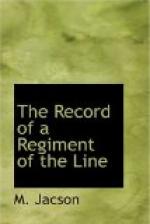One company and a Maxim gun under Captain Jacson and a squadron 5th Lancers were sent at 11 a.m. by road to Pepworth Hill to guard the left flank of General French’s force against the Free State Army, which might seriously threaten General French’s communications with Ladysmith.
At 1 p.m. further reinforcements were sent out to General French, and the three remaining companies of the Regiment were ordered to proceed by train to Modder Station to join the wing under Major Curry. The seven companies were then under the command of Major Park.
The Boers occupied two cones of some low hills overlooking Elandslaagte railway station. General French’s artillery came into action on some high ground 4400 yards distant from the Boer position, and between the two forces was an open undulating plain affording little or no cover, and across which the attack had to be delivered.
The Gordon Highlanders and Manchesters were to attack round the Boers’ left flank, whilst the Devons were to make a frontal attack.
From the nature of the position which they had taken up, no commanding positions affording flanking fire and protection to their flanks were obtainable by the Boers. These were open and could be easily threatened by the cavalry and the mounted infantry.
The Boers had two guns in position on one of the two cones, and with these guns they did good execution, knocking over a limber of one of French’s batteries at the second shot, and practically before his guns came into action.
General French’s force, now considerably augmented, marched off at 2.30 p.m. The 1st Devon Regiment was formed in company column at fifty paces as a reserve to the Manchester Regiment. After proceeding about a mile heavy firing was heard on the right front, direction was changed half-right, and the Regiment was then ordered to form for attack on the left of the Manchesters, and to take up a front of 500 yards.
Three companies were placed in the firing-line and supports under Major Park, and four companies in reserve under Major Curry. At about 3.15 p.m. the firing-line reached the top of a low hill, and came in sight of the enemy’s position distant about 4400 yards. Here a halt of a quarter of an hour was made, and at 3.30 p.m. orders were received by the Regiment to make a frontal attack on the position, to advance to within effective rifle range, and to then hold on till a flank attack by the Manchesters and Gordons came in on the right. The ground between the Regiment and the position sloped slightly up to the foot of the low rocky hills, on which the enemy was posted. There was no cover of any kind, except a few ant-heaps, in the first half of the distance.
The firing-line advanced keeping intervals and covering a front of about 600 yards, the centre being directed on to a conical hill at the back of the enemy’s camp. The reserve followed in column of companies, in single rank, at fifty paces distance between companies. The enemy’s guns opened on the Regiment at once with shrapnel, but most of the shells went high, only one striking the reserve companies.




